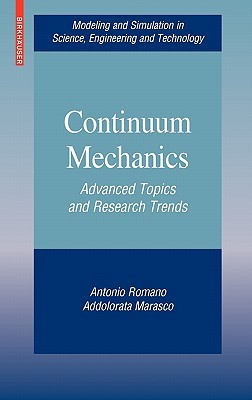
- We will send in 10–14 business days.
- Author: Antonio Romano
- Publisher: Birkhäuser
- ISBN-10: 0817648690
- ISBN-13: 9780817648695
- Format: 15.6 x 23.4 x 2.1 cm, hardcover
- Language: English
- SAVE -10% with code: EXTRA
Reviews
Description
R In the companion book (Continuum Mechanics Using Mathematica )to this volume, we explained the foundations of continuum mechanics and described some basic applications of ?uid dynamics and linear elasticity. However, deciding on the approach and content of this book, Continuum Mechanics: Advanced Topics and Research Trends, proved to be a more di?culttask.Afteralongperiodofre?ection, wemadethedecisiontodirect our e?orts into drafting a book that demonstrates the ?exibility and great potential of continuum physics to describe the wide range of macroscopic phenomena that we can observe. It is the opinion of the authors that this is the most stimulating way to learn continuum mechanics. However, it is also quite evident that this aim cannot be fully realized in a single book. Consequently, inthis book wechoseto presentonly thebasicsofinteresting continuum mechanics models, along with some important applications of them. We assume that the reader is familiar with all of the basic principles of continuum mechanics: the general balance laws, constitutive equations, isotropygroupsfor materials, the laws of thermodynamics, ordinarywaves, etc. All of these concepts can be found in Continuum Mechanics Using Mathematica and many other books. We believe that this book gives the reader a su?ciently wide view of the "boundless forest" of continuum mechanics, before focusing his or her attention on the beauty and complex structure of single trees within it (- deed, wecouldsaythatContinuumMechanics UsingMathematica provides only the fertile humus on which the trees of this forest take root!).
EXTRA 10 % discount with code: EXTRA
The promotion ends in 19d.16:48:34
The discount code is valid when purchasing from 10 €. Discounts do not stack.
- Author: Antonio Romano
- Publisher: Birkhäuser
- ISBN-10: 0817648690
- ISBN-13: 9780817648695
- Format: 15.6 x 23.4 x 2.1 cm, hardcover
- Language: English English
R In the companion book (Continuum Mechanics Using Mathematica )to this volume, we explained the foundations of continuum mechanics and described some basic applications of ?uid dynamics and linear elasticity. However, deciding on the approach and content of this book, Continuum Mechanics: Advanced Topics and Research Trends, proved to be a more di?culttask.Afteralongperiodofre?ection, wemadethedecisiontodirect our e?orts into drafting a book that demonstrates the ?exibility and great potential of continuum physics to describe the wide range of macroscopic phenomena that we can observe. It is the opinion of the authors that this is the most stimulating way to learn continuum mechanics. However, it is also quite evident that this aim cannot be fully realized in a single book. Consequently, inthis book wechoseto presentonly thebasicsofinteresting continuum mechanics models, along with some important applications of them. We assume that the reader is familiar with all of the basic principles of continuum mechanics: the general balance laws, constitutive equations, isotropygroupsfor materials, the laws of thermodynamics, ordinarywaves, etc. All of these concepts can be found in Continuum Mechanics Using Mathematica and many other books. We believe that this book gives the reader a su?ciently wide view of the "boundless forest" of continuum mechanics, before focusing his or her attention on the beauty and complex structure of single trees within it (- deed, wecouldsaythatContinuumMechanics UsingMathematica provides only the fertile humus on which the trees of this forest take root!).


Reviews